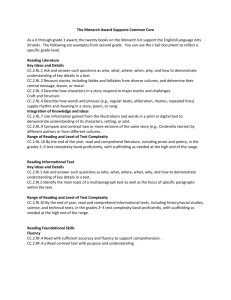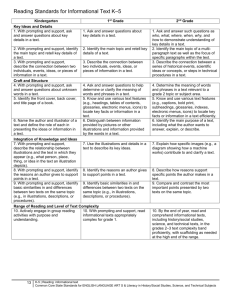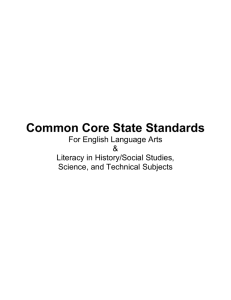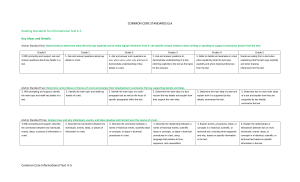Reading Vertical, K-5 - Northeast Georgia RESA
advertisement
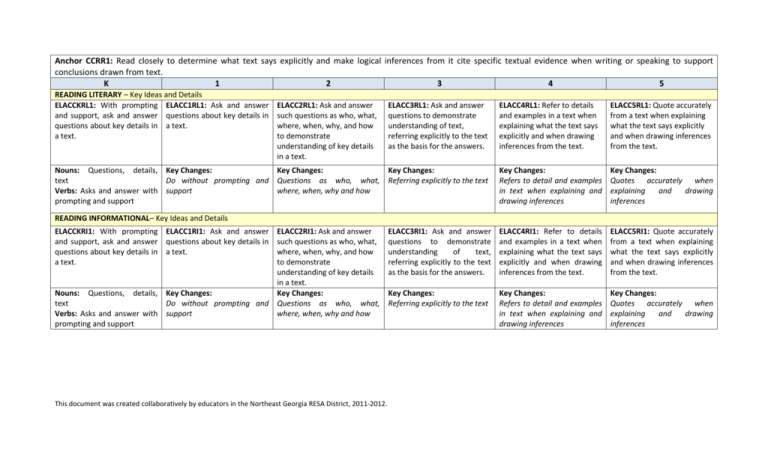
Anchor CCRR1: Read closely to determine what text says explicitly and make logical inferences from it cite specific textual evidence when writing or speaking to support conclusions drawn from text. K 1 2 3 4 5 READING LITERARY – Key Ideas and Details ELACCKRL1: With prompting ELACC1RL1: Ask and answer and support, ask and answer questions about key details in questions about key details in a text. a text. ELACC2RL1: Ask and answer such questions as who, what, where, when, why, and how to demonstrate understanding of key details in a text. ELACC3RL1: Ask and answer questions to demonstrate understanding of text, referring explicitly to the text as the basis for the answers. ELACC4RL1: Refer to details and examples in a text when explaining what the text says explicitly and when drawing inferences from the text. ELACC5RL1: Quote accurately from a text when explaining what the text says explicitly and when drawing inferences from the text. Key Changes: Refers to detail and examples in text when explaining and drawing inferences Key Changes: Quotes accurately when explaining and drawing inferences ELACC3RI1: Ask and answer questions to demonstrate understanding of text, referring explicitly to the text as the basis for the answers. ELACC4RI1: Refer to details and examples in a text when explaining what the text says explicitly and when drawing inferences from the text. ELACC5RI1: Quote accurately from a text when explaining what the text says explicitly and when drawing inferences from the text. Key Changes: Referring explicitly to the text Key Changes: Refers to detail and examples in text when explaining and drawing inferences Key Changes: Quotes accurately when explaining and drawing inferences Nouns: Questions, details, Key Changes: Key Changes: Key Changes: text Do without prompting and Questions as who, what, Referring explicitly to the text Verbs: Asks and answer with support where, when, why and how prompting and support READING INFORMATIONAL– Key Ideas and Details ELACCKRI1: With prompting ELACC1RI1: Ask and answer and support, ask and answer questions about key details in questions about key details in a text. a text. ELACC2RI1: Ask and answer such questions as who, what, where, when, why, and how to demonstrate understanding of key details in a text. Nouns: Questions, details, Key Changes: Key Changes: text Do without prompting and Questions as who, what, Verbs: Asks and answer with support where, when, why and how prompting and support This document was created collaboratively by educators in the Northeast Georgia RESA District, 2011-2012. Anchor CCRR2: Determine central ideas or themes of a text and analyze their development; summarize the key supporting details and ideas. K 1 2 3 4 READING LITERARY– Key Ideas and Details ELACCKRL2: With prompting ELACC1RL2: Retell stories, and support, retell familiar including key details, and stories, including key details. demonstrate understanding of their central message or lesson. ELACC2RL2: Recount stories, including fables and folktales from diverse cultures, and determine their central message, lesson, or moral. Nouns: stories and details Key Changes: Verbs: Retell with prompting Retell without prompting and and support support demonstrate understanding of central message READING INFORMATIONAL– Key Ideas and Details ELACCKRI2: ELACC1RI2: With prompting and support, Identify the main topic and retell, identify the main topic retell key details of text. and retell key details of a text. Key Changes: Recount and determine central message, lesson or moral. ELACC5RL2: Determine a theme of a story, drama or poem from details in the text, including how characters in a story or drama respond to challenges or how the speaker in a poem reflects upon a topic: summarize the text. Key Changes: Key Changes: Key Changes: Explain how central message Determine the theme and Determine how characters is conveyed. summarize the text. respond to challenges and how the speaker reflects. ELACC2RI2: Identify the main topic of a multi-paragraph text as well as the focus of specific paragraphs within the text. ELACC3RI2: Determine the main idea of a text; recount the key details and explain how they support the main idea. Nouns: topic and details Key Changes: Verbs: Retell, identify with Identify and retell without prompting and support prompting and support Key Changes: Identify using paragraph text a ELACC3RL2: Recount stories, including fables, folktales, and myths from diverse cultures; determine the central message, lesson, or moral and explain how it is conveyed through key details in the text. ELACC4RL2: Determine a theme of a story, drama, or poem from details in the text; summarize the text. ELACC4RI2: Determine the main idea of a text and explain how it is supported by key details; summarize the text. 5 Key Changes: multi- Determine the main idea: This document was created collaboratively by educators in the Northeast Georgia RESA District, 2011-2012. recount key details; explain how they support the main idea ELACC5RI2: Determine two or more main ideas of a text and explain how they are supported by key details; summarize the text. Key Changes: Key Changes: Determine the main idea and Use two or more main ideas. explain how it is supported; summarize the text. Anchor CCRR3: Analyze how and why individuals, events, and ideas develop and interact over the course of a text. K 1 2 3 4 5 READING LITERARY– Key Ideas and Details ELACCKRL3: With prompting and support, identify characters, settings and major events in a story. ELACC1RL3: Describe characters, settings, and major events in a story, using key details. ELACC2RL3: Describe how characters in a story respond to major events and challenges. ELACC3RL3: Describe characters in a story (e.g., their traits, motivations, or feelings) and explain how their actions contribute to the sequence of events. ELACC4RL3: Describe in depth a character, setting, or event in a story of drama, drawing on specific details in the text (e.g., a character’s thoughts, words, or actions). ELACC5RL3: Compare and contrast two or more characters, settings, or events in s story or drama, drawing on specific details in the text (e.g., how characters interact). Nouns: characters, settings, events Verbs: Identify with prompting and support Key Changes: Describe using key details Key Changes: Describe how characters respond to major events/challenges Key Changes: Explain how actions contribute to sequence of events. Key Changes: Describe in depth and drawing on specific details Key Changes: Compare and contrast two or more ELACC5RI3: Explain the relationships or interactions between two or more individuals, events, ideas, or concepts in a historical, scientific, or technical text based on specific information in the text. Key Changes: Explain the relationships or interactions between two or more individuals, events, ideas, or concepts. READING INFORMATIONAL– Key Ideas and Details ELACCKRI3: With prompting and support, describe the connection between two individuals, events, ideas, or pieces of information. ELACC1RI3: Describe the connection between two individuals, events, ideas, or pieces of information in a text. ELACC2RI3: Describe the connection between a series of historical events, scientific ideas or concepts, or steps in technical procedures in a text. ELACC3RI3: Describe the relationship between a series of historical events, scientific ideas or concepts, or steps in technical procedures in a text, using language that pertains to time, sequence, and cause/effect. ELACC4RI3: Explain events, procedures, ideas, or concepts in a historical, scientific, or technical text, including what happened and why, based on specific information in the text. Nouns: connection, individuals, events, ideas, pieces of information Verbs: Describe with prompting and support Key Changes: Describe without prompting and support Key Changes: A series of historical events, scientific ideas or concepts, or steps in technical procedures in a text Key Changes: Describe the between a series. Key Changes: Explain what and why based on specific information in text This document was created collaboratively by educators in the Northeast Georgia RESA District, 2011-2012. relationship Anchor CCRR4: Interpret words and phrases as they are used in a text, including determining technical, connotative, and figurative meanings, and analyze how specific word choices shape meaning or tone. K 1 2 3 4 5 READING LITERARY – Craft and Structure ELACCKRL4 ELACC1RL4 ELACC2RL4 ELACC3RL4 ELACC4RL4 ELACC5RL4 Ask and answer questions about unknown words in text. Identify words and phrases in stories or poems that suggest feelings and appeal to the senses. Describe how words and phrases (e.g., regular beats, alliteration, rhymes, repeated lines) supply rhythm and meaning in a story, poem or song. Determine the meaning of words and phrases as they are used in a text, distinguishing literal and non-literal language. Determine the meaning of words and phrases as they are used in a text including those that allude to significant characters found in mythology (e.g., Herculean). Determine the meaning of words and phrases as they are used in a text, including figurative language such as metaphors and similes. Nouns: questions, words, text Verbs: Ask and answer Key Changes: Indentify words and phrases that suggest feelings and appeal to the senses. Key Changes: Describe how words and phrases supply rhythm and meaning in a story, poem or song. Key Changes: Determine the meaning distinguishing literal and nonliteral language. Key Changes: Determine the meaning including those that allude to significant characters found in mythology Key Changes: Determine the meaning including figurative language such as metaphors and similes. READING INFORMATIONAL– Craft and Structure ELACCKRI4 ELACC1RI4 ELACC2RI4 ELACC3RI4 ELACC4RI4 ELACC5RI4 With prompting and support, ask and answer questions about unknown words in a text. Ask and answer questions to help determine or clarify the meaning of words and phrases in a text. Determine the meanings of words and phrases in a text relevant to a grade 2 topics or subject area. Nouns: questions, unknown word: Verbs: Ask and answer with prompting and support Key Changes: Ask and answer questions to help determine or clarify the meaning of words Key Changes: Determine the meanings of words and phrases in a text relevant to a grade 2 topics or subject area. Determine the meaning of general academic and domainspecific words and phrases in a text relevant to a grade 3 topics or subject area. Key Changes: Determine the meaning of general academic and domainspecific words and phrases in a text relevant to a grade 3 topics or subject area. Determine the meaning of general academic and domainspecific words and phrases in a text relevant to a grade 4 topics or subject area. Key Changes: grade 4 topics or subject area. Determine the meaning of general academic and domainspecific words and phrases in a text relevant to a grade 5 topics or subject area. Key Changes: grade 5 topics or subject area. This document was created collaboratively by educators in the Northeast Georgia RESA District, 2011-2012. Anchor CCRR5: Analyze the structure of texts, including how specific sentences, paragraphs, and larger portions of the text (e.g., a section, chapter, scene, or stanza) relate to each other and the whole. K 1 2 3 4 5 READING LITERARY – Craft and Structure ELACCKRL5: Recognize common types of texts (e.g., storybooks, poems). ELACC1RL5: Explain major differences between books that tell stories and books that give information, drawing on a wide reading of a range of text types. ELACC2RL5: Describe the overall structure of a story, including describing how the beginning introduces the story and the ending concludes the action. ELACC3RL5: Refer to parts of stories, dramas, and poems when writing or speaking about a text, using terms such as chapter, scene, and stanza: describe how each successive part builds on earlier sections. ELACC4RL5: Explain major differences between poems, drama, and prose, and drama (e.g., casts of characters, settings, descriptions, dialogue, stage directions) when writing or speaking about a text. ELACC5RL5: Explain how a series of chapters, scenes, or stanzas fits together to provide the overall structure of a particular story, drama, or poem. Nouns: texts Verbs: Recognize Key Changes: Explain major differences Key Changes: Describe the overall structure Key Changes: Refer to part; Describe how each successive part builds Key Changes: Explain major differences Key Changes: Explain how series fit together ELACC2RI5: Know and use various text features (e.g., captions, bold print, subheadings, glossaries, indexes, electronic menus, icons) to locate key facts or information in a text efficiently. ELACC3RI5: Use text features and search tools (e.g., key words, sidebars, hyperlinks) to locate information relevant to a given topic quickly and efficiently. ELACC4RI5: Describe the overall structure (e.g., chronology, comparison, cause/effect, problem/solution) of events, ideas, concepts, or information in a text or part of a text. ELACC5RI5: Compare and contrast the overall structure (e.g., chronology, comparison, cause/effect, and problem/solution) of events, ideas, concepts, or information in two or more texts. Key Changes: Locate facts or information in a text efficiently Key Changes: Use text features Key Changes: Describe the overall structure Key Changes: Compare and contrast the overall structure in two or more text. READING INFORMATIONAL – Craft and Structure ELACCKRI5: Identify the front ELACC1RI5: Know and use cover, back cover, and title page various text features (e.g., of a book. headings, tables of content, glossaries, electronic menus, icons) to locate key facts or information in a text. Nouns: front cover, back cover, title page, book Verbs: Identify Key Changes: Know and use various text features to locate facts or information This document was created collaboratively by educators in the Northeast Georgia RESA District, 2011-2012. Anchor CCRR6: Assess how point of view or purpose shapes the content and style of a text. K 1 2 READING LITERARY – Craft and Structure ELACCKRL6 ELACC1RL6 With prompting and support, name the author and illustrator of a story and define the role of each in telling the story. Identify who is telling the story at various points in a text. Nouns: author and illustrator, story, role Verbs: name, define Key Changes: Identify READING INFORMATIONAL – Craft and Structure ELACCKRI6 ELACC1RI6 Name the author and Distinguish between illustrator of a text and define information provided by the role of each presenting pictures or other illustrations the ideas or information in a and information provided by text. the words in the text. Nouns: author, illustrator, text role, ideas, information, text Verbs: Name, Define Key Changes: Distinguish between information provided 3 4 5 ELACC2RL6 ELACC3RL6 ELACC4RL6 ELACC5RL6 Acknowledge differences in the points of view of characters, including by speaking in a different voice for each character when reading dialogue aloud. Key Changes: Acknowledge differences in points of view Distinguish their own point of view from that of the narrator or those of the characters. Compare and contrast the point of view from which different stories are narrated, including the difference between first- and third-person narrations. Describe how a narrator’s or speaker’s point of view influences how events are described. Key Changes: Distinguish their point of view Key Changes: Compare and contrast the point of view Key Changes: Describe how a speaker’s point of view influences ELACC2RI6 Identify the main purpose of a text, including what the author wants to answer, explain, or describe. ELACC3RI6 Distinguish their own point of view from that of the author of a text. ELACC4RI6 Compare and contrast a firsthand and secondhand account of the same event or topic; describe the differences in focus and the information provided. ELACC5RI6 Analyze multiple accounts of the same event or topic, nothing important similarities and differences in the point of view they represent. Key Changes: Identify the main purpose Key Changes: Distinguish their own point of view Key Changes: Compare and contrast first hand and secondhand account; describe the differences Key Changes: Analyze multiple accounts Anchor CCRR7: Integrate and evaluate content presented in diverse formats and media, including visually and quantitatively, as well as in words. K 1 2 3 4 READING LITERARY – Integration of Knowledge and Ideas ELACCKRL7 ELACC1RL7 ELACC2RL7 ELACC3RL7 With prompting and support, Use illustrations and details in a Use information gained from the Explain how specific aspects of a This document was created collaboratively by educators in the Northeast Georgia RESA District, 2011-2012. 5 ELACC4RL7 ELACC5RL7 Make connections between the Analyze how visual and describe the relationship between illustrations and the story in which they appear (e.g., what moment in a story an illustration depicts). story to describe its characters, setting, or events. illustrations and words in a print or digital text to text to demonstrate understanding of its characters, setting or plot. text’s illustrations contribute to what is conveyed by the words in a story (e.g., create mood, emphasize aspects of a character or setting). Nouns: relationship, illustration, story Verbs: describe Key Changes: Use illustration and details to describe Key Changes: Use information to explain. Key Changes: Explain how specific aspects contribute, text of a story or drama and a visual or oral presentation of the text, identifying where each version reflects specific descriptions and directions in the text. Key Changes: Make connections. multimedia elements contribute to the meaning, tone and beauty of a text (e.g., graphic novel, multimedia, presentation of fiction, folktale, myth, poem). Key Changes: Analyze how elements contribute READING INFORMATIONAL – Integration of Knowledge and Ideas ELACCKRI7 ELACC1RI7 ELACC2RI7 ELACC3RI7 ELACC4RI7 ELACC5RI7 With prompting and support, describe the relationship between illustrations and the text in which they appear (e.g., what person, place, thing, or idea in the text an illustration depicits). Use illustrations and details in a text to describe its key ideas. Explain how specific images (e.g., a diagram showing how a machine works) contribute to and clarify a text. Use information gained from illustrations (e.g., maps, photographs) and the words in a text to demonstrate understanding of the text (e.g., where, when, why, and how key events occur) Draw on information from multiple print or digital sources, demonstrating the ability to locate an answer to a question quickly or to solve a problem efficiently. Nouns: relationship, illustration, story Verbs: describe Key Changes: Use illustration and details to describe Key Changes: Explain how specific aspects contribute, Key Changes: Use information to explain. Interpret information presented visually, orally, or quantitatively (e.g., in charts, graphs, diagrams, time lines, animations, or interactive elements on Web pages) and explain how the information contributes to an understanding of the text in which it appears. Key Changes: Interpret information and explain how the information contribute This document was created collaboratively by educators in the Northeast Georgia RESA District, 2011-2012. Key Changes: Draw on information Anchor CCRR8: Delineate and evaluate the argument and specific claims in text, including the validity of reasoning as well as the relevance and sufficiency of the evidence. K 1 2 3 4 5 READING LITERARY – Integration of Knowledge and Ideas ELACCKRL8 ELACC1RL8 ELACC2RL8 ELACC3RL8 ELACC4RL8 ELACC5RL8 ELACC3RI8 Describe the logical connection between particular sentences and paragraphs in a text (e.g., comparison, cause/effect, first/second/third in sequence). ELACC4RI8 Explain how an author uses reasons and evidence to support particular points in a text. ELACC5RI8 Explain how an author uses reasons and evidence to support particular points in a text, identifying which reasons and evidence supports which point(s). Key Changes: Describe logical connections Key Changes: Explain how an author uses reasons and evidence to support Key Changes: Explain how an author uses reasons and evidence to support, identifying which reasons and evidence supports which point (Not applicable to literature) READING INFORMATIONAL – Integration of Knowledge and Ideas ELACCKRI8 ELACC1RI8 ELACC2RI8 With prompting and support, Identify the reason an author Describe how reasons identify the reasons an author gives to support points in a support specific points the gives to support points in a text. author makes in a text. text. Nouns: reasons, author, points, text Verbs: identify Key Changes: Without prompting and support, identify Key Changes: Describe how reasons support Anchor CCRR9: Analyze how two or more texts address similar themes or topics in order to build knowledge or to compare the approaches the authors take. K 1 2 3 4 READING LITERARY – Integration of Knowledge and Ideas ELACCKRL9 ELACC1RL9 With prompting and support, Compare and contrast the compare and contrast the adventures and the experiences ELACC2RL9 Compare and contrast two of more versions of the same story This document was created collaboratively by educators in the Northeast Georgia RESA District, 2011-2012. ELACC3RL9 Compare and contrast the themes, settings, and plots of ELACC4RL9 Compare and contrast the treatment of similar themes and 5 ELACC5RL9 Compare and contrast stories in the same genre (e.g., mysteries adventures and experiences of characters in familiar stories. of characters in stories. (e.g., Cinderella stories) by different authors of from different cultures. stories written by the same author about the same or similar characters (e.g., in books from a series). Nouns: adventures, experiences, characters, stories Verbs: Compare and Contrast Key Changes: Without prompting and support, Compare and contrast Key Changes: Compare and contrast two or more Key Changes: Compare and contrast the themes, setting and plots ELACC2RI9 Compares and contrast the most important points presented by two texts on the same topic. Key Changes: Compare and contrast the most important points READING INFORMATIONAL – Integration of Knowledge and Ideas ELACCKRI9 ELACC1RI9 With prompting and support, Identify basic similarities in and identify basic similarities in differences between two texts differences between two texts on the same topic (e.g., in on the same topic (e.g., in illustrations, descriptions, or illustrations, descriptions, or procedures). procedures). Nouns: texts, topic, illustrations, Key Changes: descriptions, procedures Without prompting and support, Verbs: Identify identify topics (e.g., opposition of good and evil) and patterns of events (e.g., the quest) in stories, myths, and traditional literature from different cultures. Key Changes: Compare and contrast the treatment of similar themes and topics and adventures stories) on their approaches to similar themes and topics. ELACC3RI9 Compares and contrast the most important points and key details presented in two texts on the same topic. ELACC4RI9 Integrate information from two texts on the same topic in order to write or speak about the subject knowledgeably. ELACC5RI9 Integrate information from several texts on the same topic in order to write or speak about the subject knowledgeably. Key Changes: Compare and contrast the most important points and key details in two texts Key Changes: Integrate information from two texts Key Changes: Integrate information from several texts Anchor CCRR10: Read and comprehend complex literary and informational texts independently and proficiently. K 1 2 3 READING LITERARY – Range of reading and Level of Text Complexity ELACCKRL10 ELACC1RL10 ELACC2RL10 Actively engage in group reading activities with purpose and understanding. With prompting and support, read prose and poetry of appropriate complexity for grade 1. Nouns: group activities Key Changes: By the end of the year, read and comprehend literature, including stories and poetry, in the grades 2-3 text complexity band proficiently, with scaffolding as needed at the high end of the range. Key Changes: This document was created collaboratively by educators in the Northeast Georgia RESA District, 2011-2012. Key Changes: Compare and contrast stories in the same genre 4 5 ELACC3RL10 ELACC4RL10 ELACC5RL10 By the end of the year, read and comprehend literature, including stories, dramas, and poetry at the high end of the grades 2-3 text complexity bands independently and proficiently. By the end of the year, read and comprehend literature, including stories, dramas, and poetry, in grades 4-5 text complexity band proficiently, with scaffolding as needed at the high end of the range. Key Changes: By the end of the year, read and comprehend literature, including stories, dramas, and poetry at the high end of the grades 4-5 text complexity bands independently and proficiently. Key Changes: Key Changes: Verbs: Actively engage With prompting and support read literary text appropriate complexity for grade1 Read and comprehend literacy text in the grades 2-3 text complexity band proficiently, with scaffolding as needed at the high end of the range. READING INFORMATIONAL - Range of reading and Level of Text Complexity ELACCKRI10 ELACC1RI10 ELACC2RI10 Actively engage in group reading activities with purpose and understanding. With prompting and support, read informational texts appropriately complexity for grade 1. Nouns: group activities Verbs: Actively engage Key Changes: With prompting and support read informational text appropriate complexity for grade1 By the end of the year, read and comprehend informational texts, including history/social studies, science, and technical texts, in the grades 2-3 text complexity band proficiently, with scaffolding as needed at the high end of the range. Key Changes: Read and comprehend informational text in the grades 2-3 text complexity band proficiently, with scaffolding as needed at the high end of the range. This document was created collaboratively by educators in the Northeast Georgia RESA District, 2011-2012. Read and comprehend literacy text in the grades 2-3 text complexity band independently and proficiently, Read and comprehend literacy text in the grades 4-5 text complexity band proficiently, with scaffolding as needed at the high end of the range. Read and comprehend literacy text in the grades 4-5 text complexity band independently and proficiently, ELACC3RI10 ELACC4RI10 ELACC5RI10 By the end of the year, read and comprehend informational texts, including history/social studies, science, and technical texts, at the high end of the grades 2-3 text complexity band independently and proficiently. By the end of the year, read and comprehend informational texts, including history/social studies, science, and technical texts, in the grades 4 - 5 text complexity band proficiently, with scaffolding as needed at the high end of the range. Key Changes: Read and comprehend informational text in the grades 4-5 text complexity band proficiently, with scaffolding as needed at the high end of the range. By the end of the year, read and comprehend informational texts, including history/social studies, science, and technical texts, at the high end of the grades 4 - 5 text complexity band independently and proficiently. Key Changes: Read and comprehend Informational text in the grades 2-3 text complexity band independently and proficiently, Key Changes: Read and comprehend informational text in the grades 4-5 text complexity band independently and proficiently,
